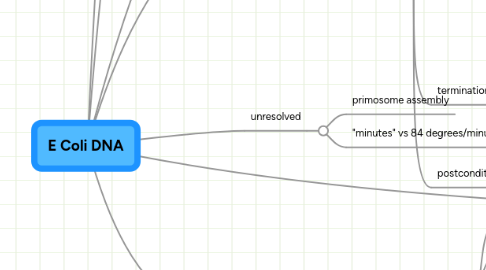
1. Restriction / Modification System
1.1. Modification Methylase
1.1.1. protect DNA from unneeded "repair"
1.1.2. role in repair
1.1.3. differentiate template strand
1.2. topoisomerases
2. Replication
2.1. preconditions
2.1.1. transcription factors
2.1.1.1. DnaA
2.1.2. nutrients (fixed growth vs change)
2.1.2.1. magic spot
2.2. @oric
2.2.1. terms
2.2.1.1. IHF, R1-R5,FIS, IHF, ATP DnaBoxes
2.3. polymerization
2.4. replication errors
2.5. terms
2.5.1. helicase
2.5.2. dna gyrase
2.5.3. SSB
2.5.4. DNAPIII
2.5.4.1. structural model
2.5.4.2. holoenzyme (protein complex)
2.5.4.3. domains (hand)
2.5.5. Primosome Assembly Site
2.5.5.1. PriA
2.5.5.2. PriB
2.6. termination
2.6.1. ter sites
2.6.2. normal
2.6.3. failsafe
2.6.4. dif
2.7. postconditions
3. Structure&Topology
3.1. pyrimidine
3.2. purine
3.3. major/minor groove
3.3.1. GC=3, AT=2
3.4. topoisomerases
3.4.1. precondition
3.4.1.1. relax supercoils
3.4.2. postcondition
3.4.2.1. add +1 or +2 twists
3.4.2.2. removes negative supercoils
3.4.2.3. change DNA topology
3.4.3. types
3.4.3.1. I
3.4.3.1.1. "steps of 1"
3.4.3.2. II
3.4.3.2.1. steps of 2
3.4.3.2.2. require ATP
3.5. conformations: b, a, z DNA
3.6. Linking = twists + writh (heteroduplex)
3.7. phosphodiester
3.8. sugar-phosphate
4. Analysis Techniques
4.1. Gel Electrophoresis
4.1.1. Northern Blot
4.1.1.1. RNA
4.1.2. Southern Blot
4.1.2.1. DNA
4.1.3. Western BLot
4.1.3.1. Protein
4.1.4. use in deletion analysis
4.1.5. use in restriction site mapping
4.2. restriction site mapping
5. DNA damage & repair
5.1. Replication Errors
5.1.1. Mismatch Repair System
5.1.2. Exonucleases
5.2. spontaneous
5.2.1. Oxidative
5.2.1.1. oxoG
5.2.1.2. OH radical
5.2.1.3. Superoxide
5.3. chemical damage
5.3.1. aflotoxin (stored grain)
5.3.2. bezno2pyrene(smokers)
5.4. UltraViolet Radiation
5.4.1. thymine dimer
5.5. Repair
5.5.1. reverse (undo)
5.5.2. excision (del, pol new)
5.5.3. Recombinatorial
5.6. Nucleotide Excision Repair (NER)
5.6.1. precondition
5.6.2. BIG molecules, major deformities
5.6.3. repairs chemical damage
5.6.4. repairs Ultra Violet Radiation
5.6.5. proteins
5.6.5.1. UvrA
5.6.5.2. UvrB
5.6.5.3. UvrC
5.6.5.4. mechanism
5.7. Base Excision Repair
5.7.1. precondition
5.7.2. mechanism & BER pathway
5.7.2.1. terms
5.7.2.1.1. DNA glycosylase
5.7.2.1.2. AP Site
5.7.2.1.3. AP endonuclease
5.7.2.1.4. DRPase
5.7.2.1.5. DNAPI
5.7.2.1.6. DNA Ligase
5.7.3. postcondition
5.7.4. small molecules, minor DNA deformities
5.7.5. Repairing Oxidative Damage
5.7.5.1. OH radical
5.7.6. New node
5.7.7. Glycosylates (related)
5.7.7.1. DNA glycosylase
5.7.7.2. Thymine Glycol
5.7.7.3. methylation
5.7.7.4. spontaneous C-->U
5.8. Adaptive Response "methyl group repair"
5.8.1. methylating agents
5.8.2. repair proteins
5.8.2.1. Glycosylates
5.8.2.1.1. AlkA
5.8.2.1.2. Tag
5.8.3. Directly Reversible
5.8.3.1. AlkB
5.8.3.1.1. turnover
5.8.3.1.2. inducible
5.8.3.2. ogt
5.8.3.2.1. No turnover (not enzyme)
5.8.3.2.2. not inducible
5.8.3.3. Ada
5.8.3.3.1. inducible
5.8.3.3.2. mechanism
5.8.4. mechanism of induction
5.8.5. SOS response
5.8.5.1. UmuC, UmuD
5.8.5.2. RecA
5.8.5.2.1. also involved with recombination
5.9. DNA repair involving no lesion removal
5.9.1. recombinatorial repair
5.9.2. lesion bypass DNAP
5.9.3. damage avoidance mechanism
5.9.4. phenomenology
